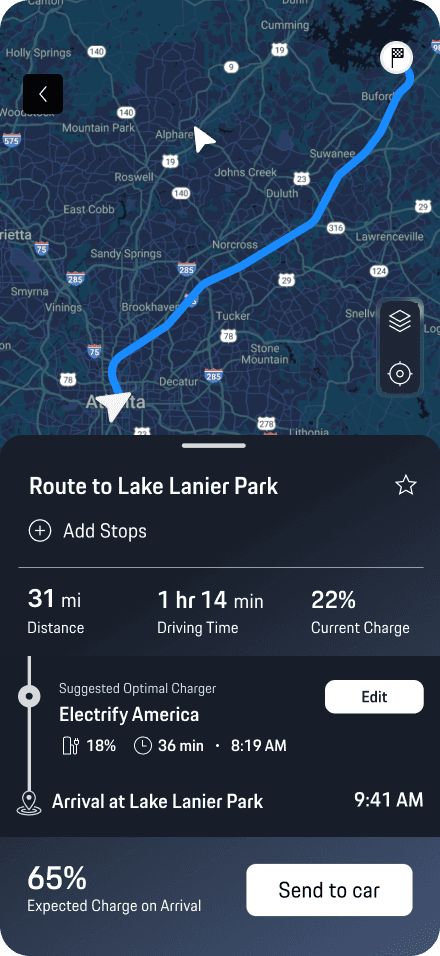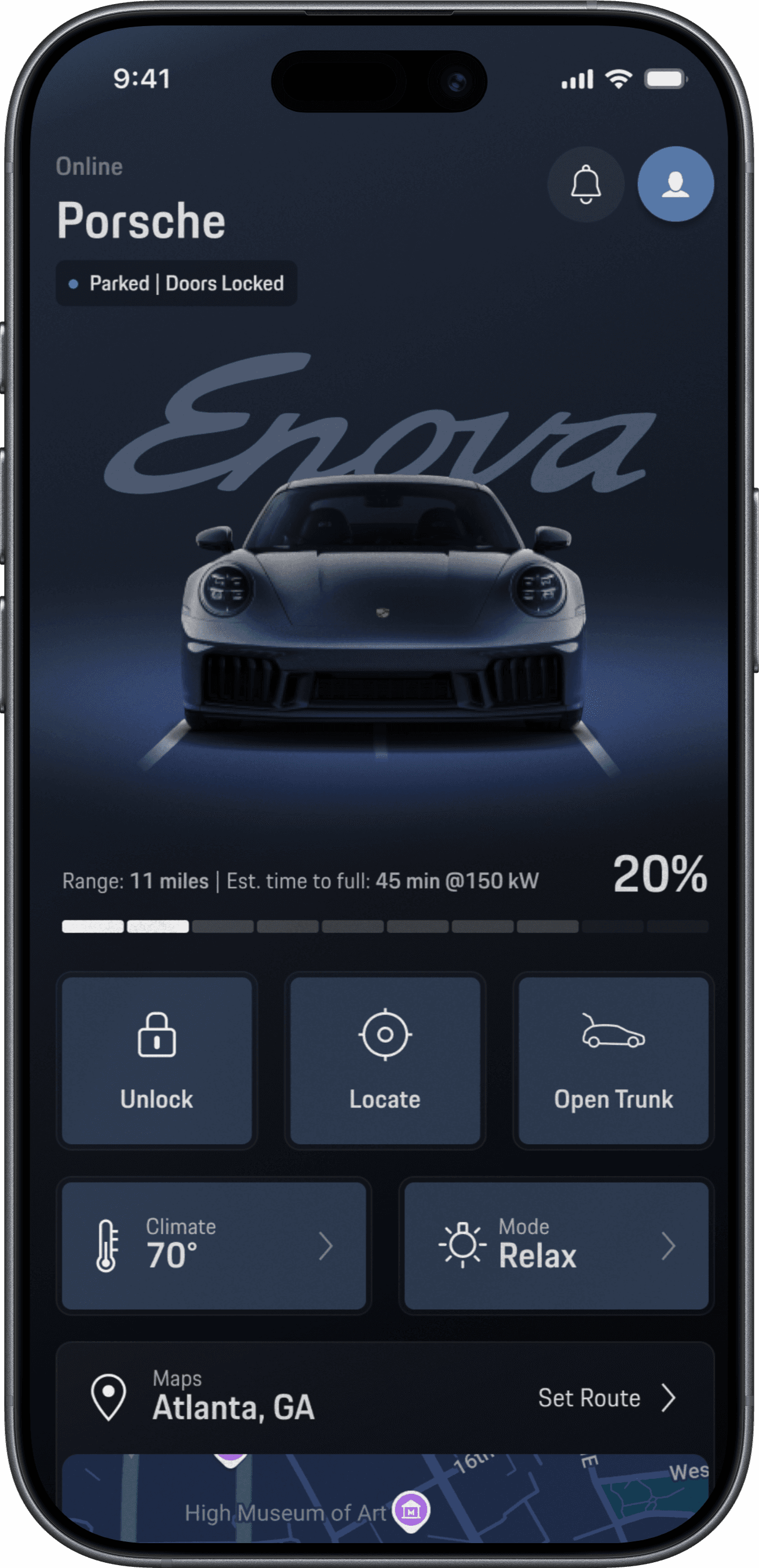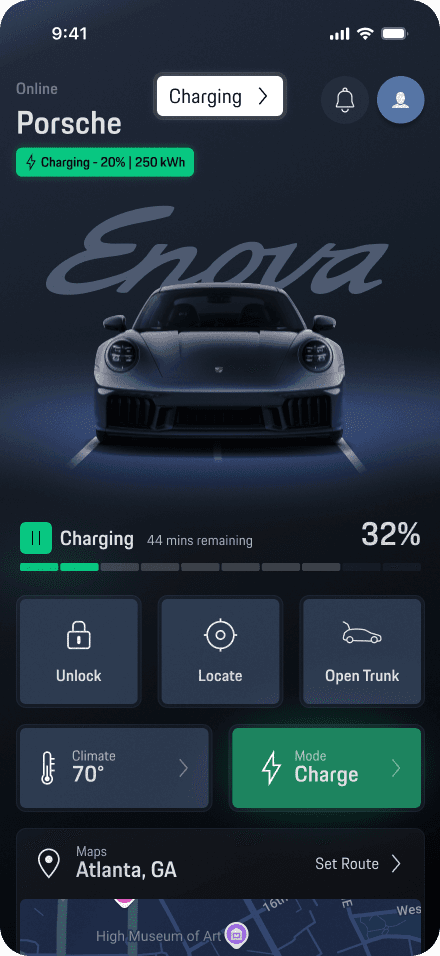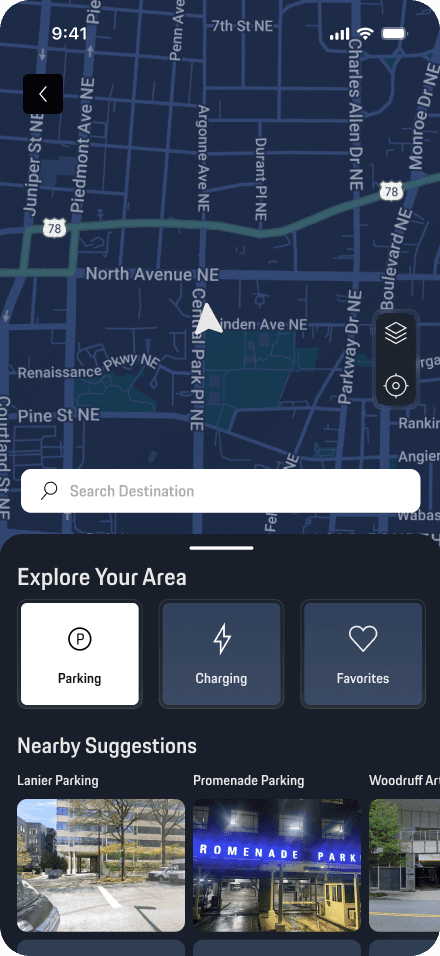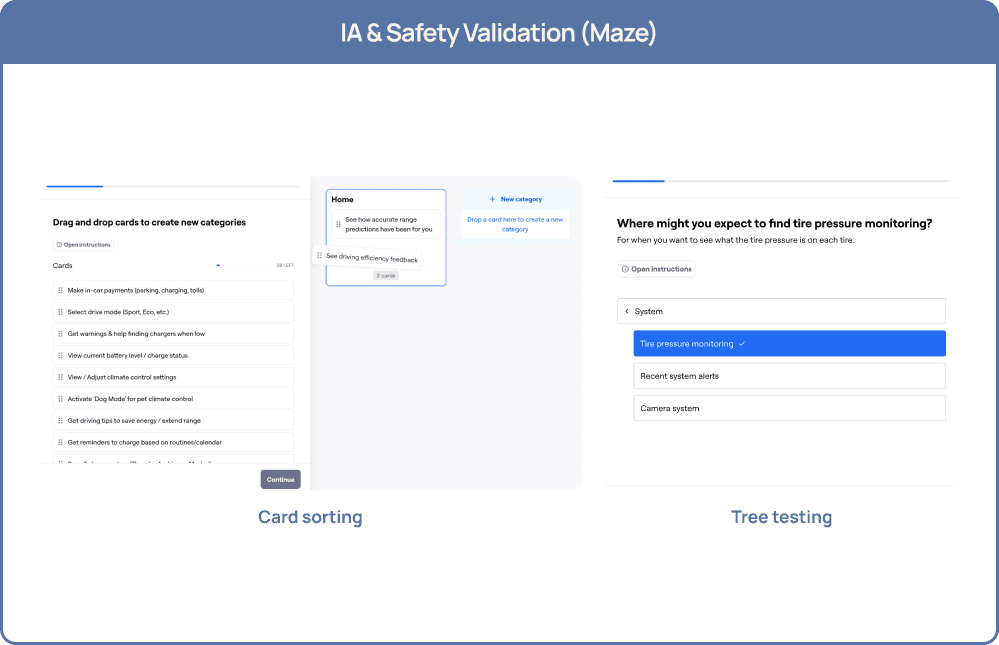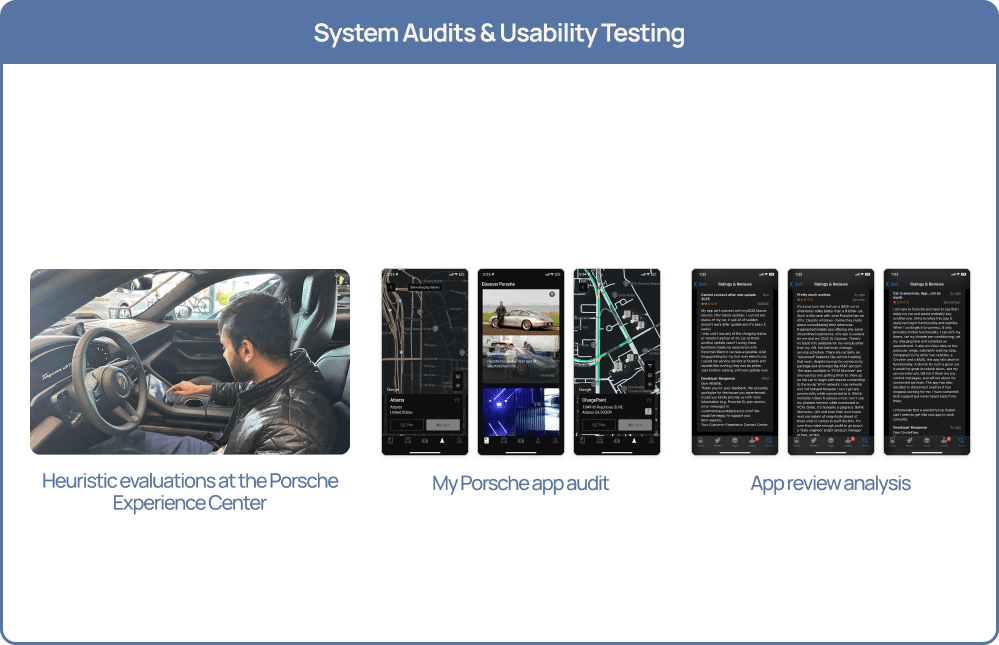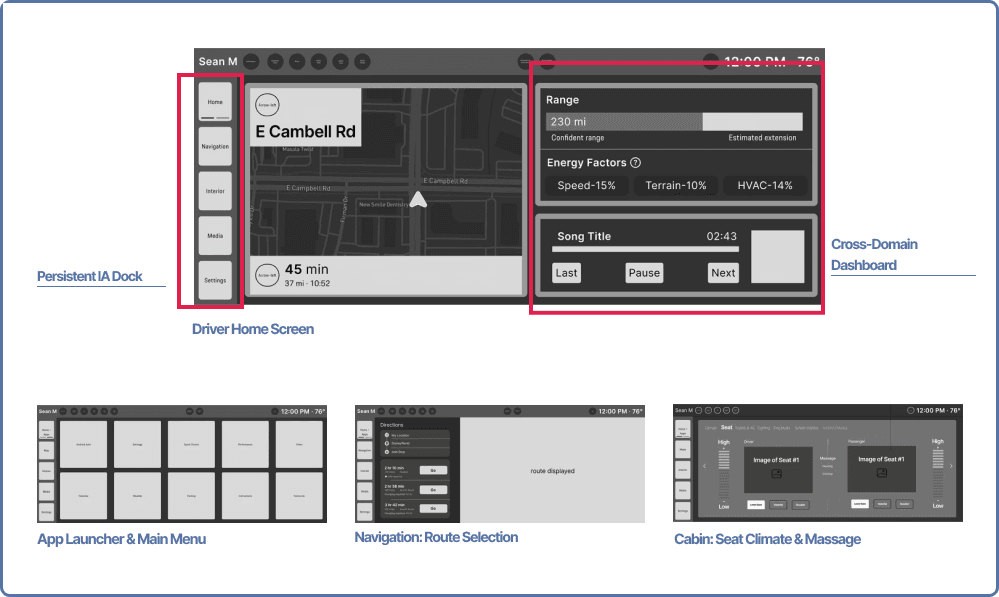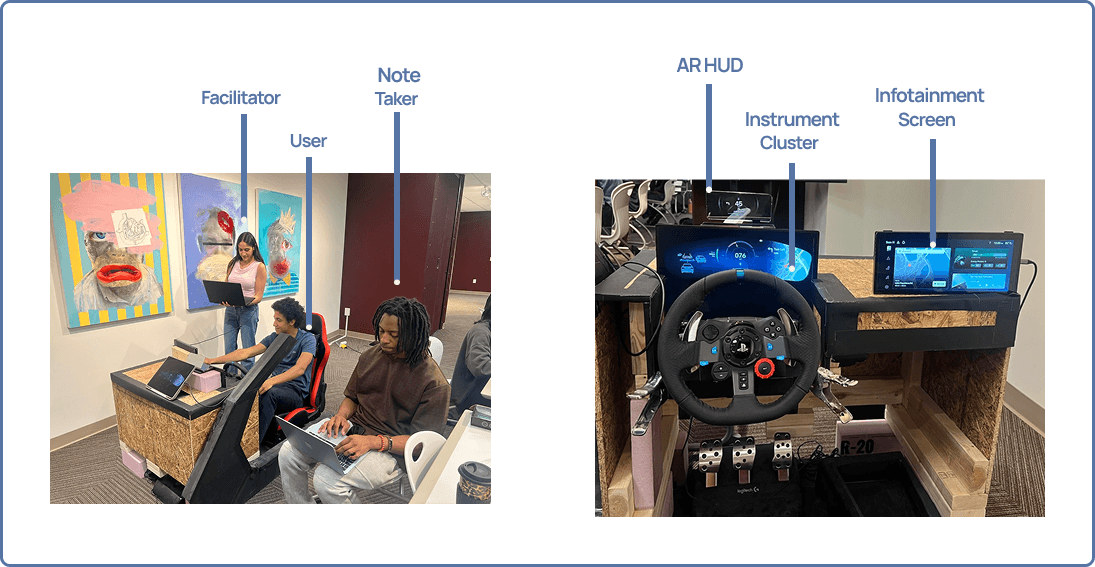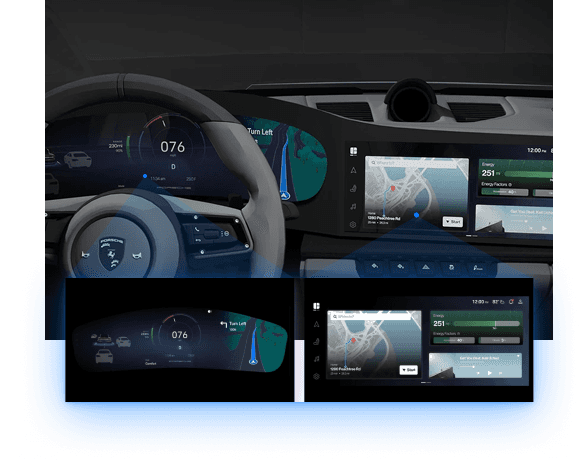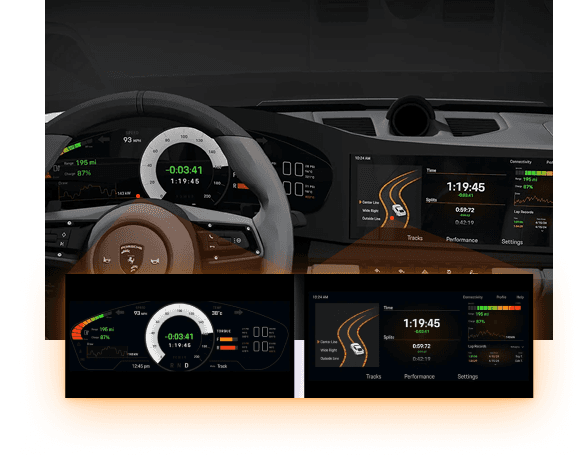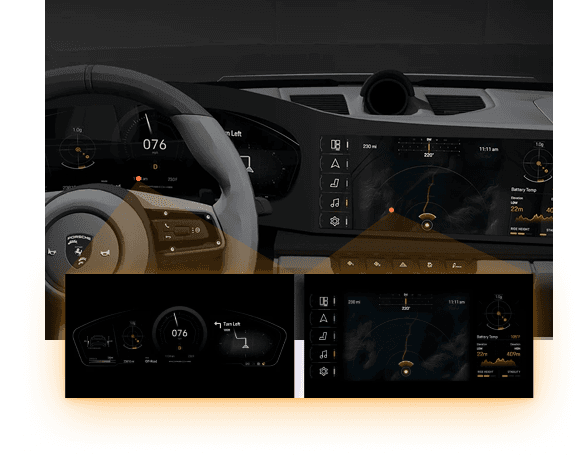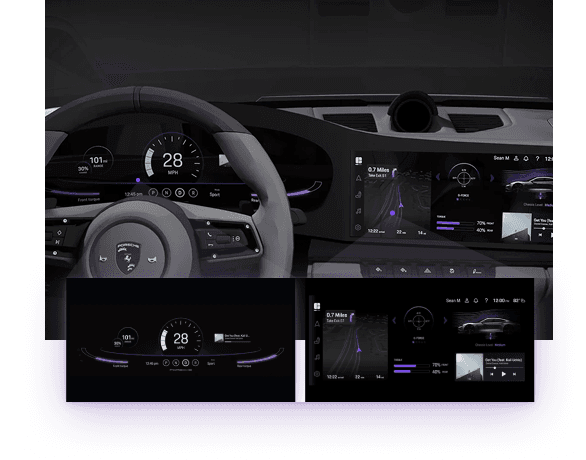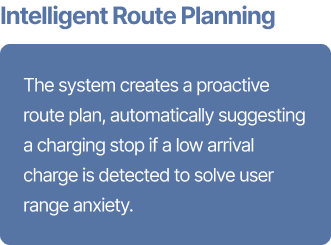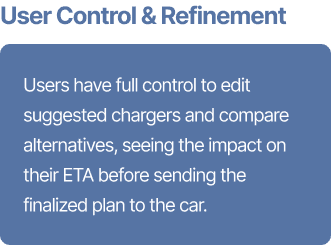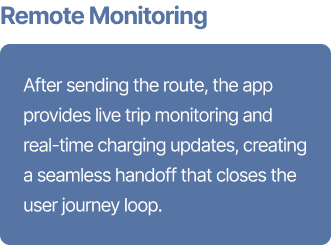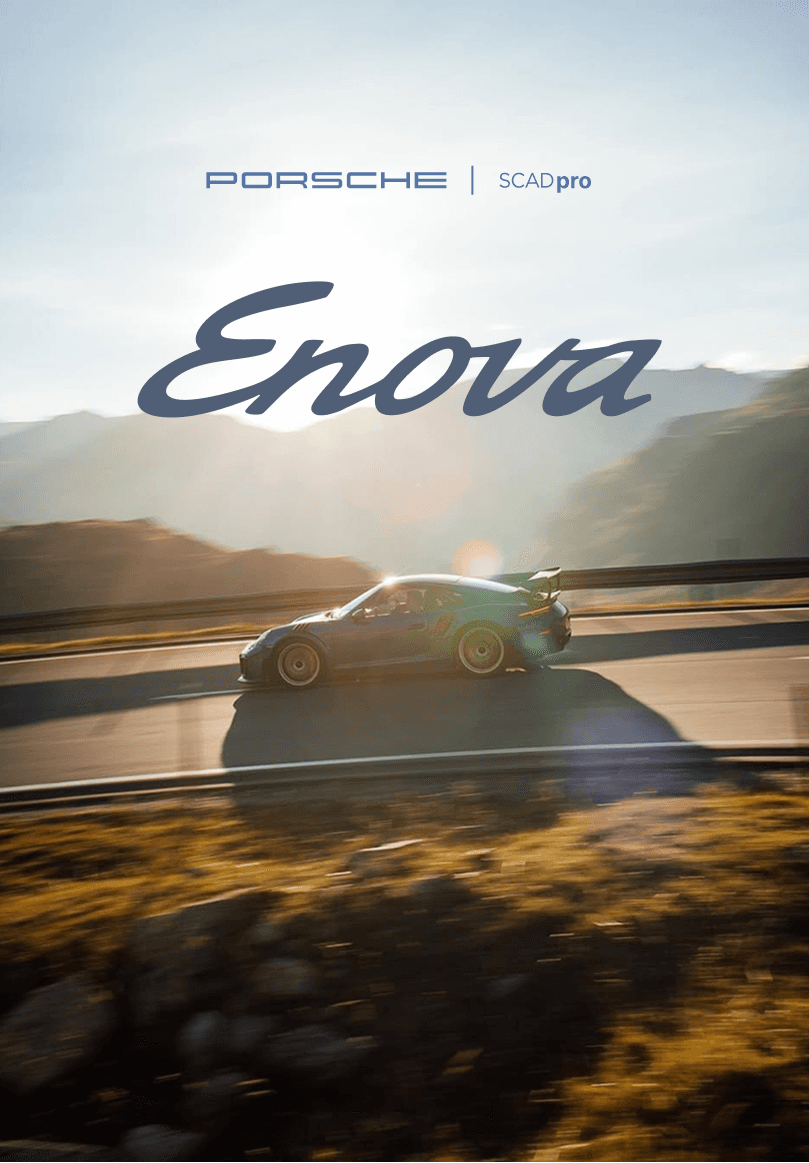The project itself :
Project Overview
As part of a 10-week SCADpro collaboration with Porsche, our team designed a next-generation in-vehicle experience for Porsche’s future electric vehicles. We focused on the digital ecosystem across the instrument cluster, center display, and companion app to reduce range anxiety, clarify EV-specific information, and keep the experience true to Porsche’s performance-driven brand.
Problem:
Drivers transitioning to electric vehicles often feel overwhelmed by fragmented interfaces, buried charging features, and unclear feedback about range, battery health, and performance. In Porsche’s context, this can lead to range anxiety, hesitation when planning trips or charging, and a disconnect between the digital experience and the brand’s confident, driver-focused identity.
Goal:
Design an integrated HMI system that helps Porsche EV drivers understand “what’s happening” at a glance, confidently plan charging and trips, and stay focused on the road—while expressing Porsche’s brand through clear information architecture, intuitive interactions, and purposeful motion across the cluster, center screen, and companion app.
Tools:
Figma
FigJam
ProtoPie
Responsibilities:
conducting secondary research on EV UX, range anxiety, and competitor HMIs,
mapping information architecture, user journeys, and key in-car flows,
defining interaction patterns and motion language for the cluster and center display,
creating low- to high-fidelity wireframes and screen designs,
building interactive ProtoPie prototypes to showcase key driving and charging scenarios,
collaborating with industrial and graphic design teams and co-presenting final concepts to Porsche stakeholders.
All about the user :
User Research
I collaborated with the team to combine expert EV HMI benchmarking, 30+ in-depth interviews, 160+ survey responses, and Reddit/forum mining to understand how current and aspiring Porsche EV drivers plan trips, manage charging, and use companion apps today. I was part of the research synthesis for the infotainment and app experiences; using card sorts, tree tests, and app audits to validate our information architecture; so that later motion and interaction decisions in the Porsche app were grounded in real driver needs, not just aesthetics.
Pain Points
Fragmented planning and charging
Drivers bounce between navigation apps, charger networks, and the My Porsche app just to plan one EV trip, making it hard to see route, chargers, costs, and real-time vehicle status in one place.
Range anxiety and low trust in information
People don’t fully trust current range estimates or charger availability; unclear terminology and buried charging details make it hard to know “Will I actually make it, and where should I stop?”
Tech that erodes Porsche confidence
Younger, tech-forward drivers want smart, connected features, while loyal owners worry that clunky UIs, lag, and “beta-feeling” apps distract from the purity of driving and dilute the Porsche brand.
Target Audiences
Our research focused on three EV buyer groups so the experience could serve tech-forward newcomers and loyal Porsche owners alike: first-time Porsche buyers, existing owners exploring electric models, and EV owners outside the Porsche ecosystem that Porsche hopes to win over.
Primary First-time Porsche Buyers (Next-Gen Enthusiasts)
Late-20s to early-40s drivers entering the Porsche world for the first time. They expect their EV and companion app to feel as smart and connected as the rest of their devices.
Secondary Existing Porsche Owners (Loyal Legacy Owners)
40–50-something Porsche drivers who love the brand’s purity and are exploring electric models but worry that too much tech could interfere with the driving feel they trust.
Tertiary EV Owners Outside Porsche (EV Switchers)
Drivers who already own other EVs (like Tesla) and are curious whether Porsche can offer a more confident, premium EV ecosystem across cockpit, app, and interior.
Research Methods & Testing
A layered mix of benchmarking, real-world voices, IA validation, and usability testing shaped how we redesigned the mobile EV flow.
I helped synthesize four major research streams: expert EV HMI teardowns and an integrated feature matrix, real-world driver feedback from interviews, surveys, and Reddit/forum mining, IA validation through Maze card sorts and tree tests, and system audits of Porsche’s EV cockpit and My Porsche app. This evidence directly informed the information architecture and interactions for the pre-departure route planning flow in the mobile app.
Goal
Ground the Porsche EV mobile experience—especially pre-departure route planning—in evidence, so drivers can plan, send, and monitor trips with fewer taps, clearer feedback, and higher confidence.
The project schematically :
Starting the Design
With our research and IA validation in place, I moved into designing the Porsche EV ecosystem. First, we rebuilt the information architecture for the infotainment and instrument cluster, then extended the same logic and visual language into the Porsche app. On the mobile side, I worked on the redesign of the pre-departure Trip Planner flow and its motion, turning our range-anxiety insights into a glance-safe, Porsche-grade experience.
Information Architecture
Rebuilding navigation for glance-safe driving and scalable EV features.
My first step was to validate and then rebuild the system’s information architecture. Iterative tree testing took the baseline in-car IA from a 36.4% direct-hit rate to 84% and cut average menu depth in half, so driver-critical tasks are always within two taps. This architecture became the backbone for the driver home, app launcher, and cross-domain dashboard. I then adapted the same structure for the My Porsche app, centering everything around a single pre-departure Trip Planner flow instead of scattered charging and route features.
+130% findability First-time Porsche Buyers (Next-Gen Enthusiasts)
Direct-hit rate improved from 36.4% → 84% after IA refinements.
50% shallower menus First-time Porsche Buyers (Next-Gen Enthusiasts)
Settings depth was cut in half, reducing how often drivers get lost in nested screens.
≤ 2 taps for critical tasks
All driver-critical actions were streamlined to be reachable within two taps or less.
Infotainment & Cluster Wireframes
Defining the core layouts and states for the in-car system.
Using the validated IA as our blueprint, I worked with the in-car team to block out key screens for the driver home, app launcher, route selection, and cabin comfort. The wireframes introduce a persistent IA dock to prevent drivers from getting lost in deep menus and a cross-domain dashboard that surfaces navigation, energy, and media in one glance. While my main focus was the mobile experience, I reviewed and refined these wireframes to keep the in-car system aligned with the Trip Planner and our overall EV story.
Mobile App: Trip Planner Flow
Mapping the end-to-end EV journey in low-fidelity before visual design and motion.
In parallel, I worked on the end-to-end redesign of the My Porsche Trip Planner flow, choosing pre-departure planning because it’s both high-impact and poorly executed in most OEM apps. Starting from low-fidelity sketches and moving into detailed Figma wireframes, I shaped a single, continuous sequence — Home → Search Destination → Route Overview → Send to Vehicle → Live Trip Card → Charging Overview — so drivers can plan, send, and monitor a trip without hunting through menus. The flow is guided by three design principles: Driver-First Clarity, Performance-with-Personalization, and Ecosystem Consistency, keeping the app as refined as the car itself.
Usability Studies
Validating both in-car and mobile flows with real drivers.
To make sure the ecosystem felt as intuitive as it looked, I helped run five rounds of usability testing across 32 participants, combining an in-person cockpit rig with Maze-based remote tests. For the mobile Trip Planner flow, I tracked task success, mispresses, and SUS scores. Our final moderated and unmoderated tests scored 86.5 (mobile app) and 74 (Infotainment and cluster) on the System Usability Scale (vs. a 68 industry average), placing the experience in the top tier of usability and confirming that drivers can now plan and send EV routes with less friction and greater confidence.
Higher success, lower friction
IA and flow refinements raised task success to 96% while reducing task time and mispresses across key Trip Planner tasks.
Confidence in range & charging
Arrival-battery and live trip card patterns eased range anxiety; participants reported feeling sure they would “make it” and clearly understood when and where charging would occur.
Consistent Porsche feel across touchpoints
A shared visual language between cluster, PCM, and app reinforced brand pride and made the system feel like one Porsche ecosystem, not separate products.
Mobile App Design System
After validating the IA and Trip Planner lo-fis, I focused fully on the My Porsche mobile app, joining the team that established its design system. We built a reusable library so EV features like Trip Planner could scale without redesigning every screen.
After validating the information architecture and Trip Planner flow through lo-fi wireframes and usability tests, I shifted my focus entirely to the My Porsche mobile app. As part of a small design systems team, I helped establish a reusable visual language and component library that could support our EV Trip Planner and future features. Grounded in our three design principles—Driver-First Clarity, Performance-with-Personalization, and Ecosystem Consistency—the system makes the app feel as refined on screen as a Porsche does on the road and is ready to scale with new EV capabilities.
Typography
Defined a Porsche Next type scale for clear hierarchy—from hero vehicle and route info down to dense trip details.
Color & Themes
Set functional colors and light/dark themes to signal state (charge, alerts, status) rather than just decorate.
Icons & Tokens
Standardized iconography and created spacing/radius tokens and core components (cards, buttons, nav) so every screen feels consistently “Porsche.”
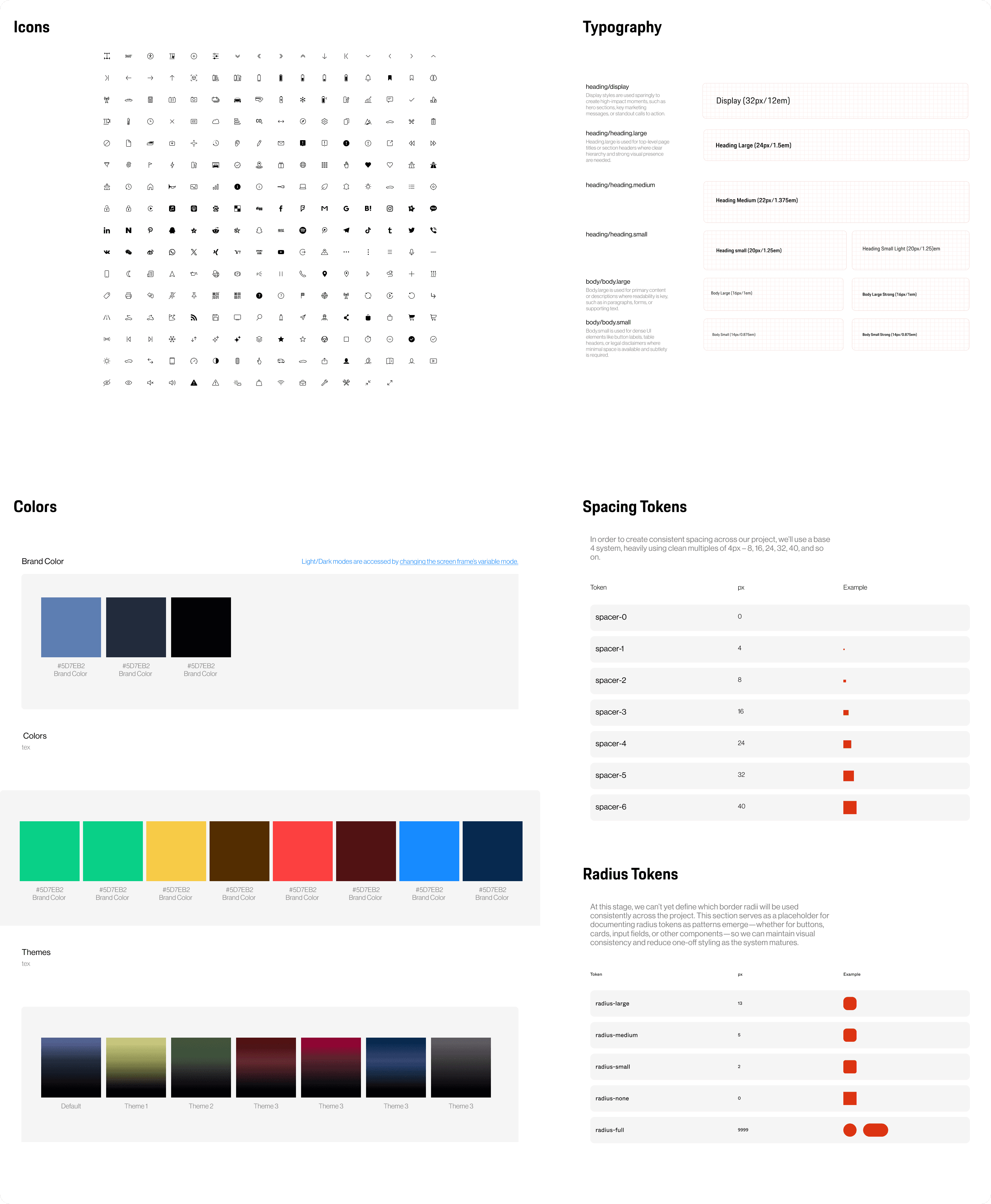
The clear version :
Refining Design
With the IA validated and the mobile design system in place, I moved into refining the visuals. On the in-car side, our lo-fi cockpit wireframes evolved into four driving modes—Comfort, Track, Off-Road, and Sport—all sharing the same IA but tuned for different contexts. In parallel, I focused on the My Porsche Trip Planner flow, bringing it to life with high-fidelity screens, motion, and interactions that feel unmistakably Porsche.
Mockups
High-fidelity screens for the final ecosystem.
I created high-fidelity screens for the mobile Trip Planner and collaborated on key infotainment states, applying our Porsche Next type system, color themes, and iconography. The mocks show the full EV journey—from home and map explore to route overview, live trip monitoring, and charging—so stakeholders could see how the experience holds together across phone and cockpit.
High-fidelity prototype
Interactive motion built in ProtoPie.
To test the Trip Planner in a realistic way, I rebuilt the flow as an interactive prototype in ProtoPie. I imported my Figma components, wired up each step with tap and scroll triggers, and used ProtoPie’s timeline to animate transitions, confirmations, and subtle state changes (like charger selection and “sent to car” feedback). This prototype was then used in Maze and in-person cockpit sessions to capture SUS scores and qualitative feedback.
Looking back on it :
Outcome
Looking back at the project, I wanted to highlight what changed for drivers and for Porsche, and what I personally learned from leading the mobile Trip Planner flow and its motion—plus how I’d evolve the system next.
Takeways
The key outcomes for drivers, Porsche, and the product ecosystem.
Impact:
The redesigned EV ecosystem made planning and driving feel more confident and connected. A clearer IA, four cockpit modes, and a focused Trip Planner flow reduced the friction of finding features, planning routes, and understanding range. The mobile app, cluster, and center display now tell a single, consistent story—helping drivers trust the car, not wrestle with the interface.
What I learned:
This project reinforced that structure comes before styling—getting the IA, flows, and copy right made every later motion and visual decision easier. I also learned how powerful a shared design system is when you’re designing across screens, and how tools like ProtoPie can turn static UI into a cinematic story that stakeholders and drivers instantly “get.”
Next Steps
How I’d extend the Porsche EV experience if we continued the work.
Explore how Trip Planner can support everyday EV use, not just long trips—surfacing smart suggestions for frequent routes, routine charging, and errands.
Layer in more adaptive intelligence across mobile and in-car—learning driver preferences over time and adjusting charger suggestions, notifications, and visual emphasis to each driver’s habits.
A deep dive into the process :
Process Book
For a deeper dive into the technical details and the project journey, check out the process book!

